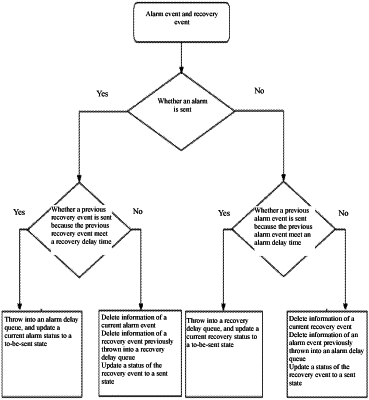| CPC G06F 11/0793 (2013.01) [G06F 11/079 (2013.01); G06F 11/0772 (2013.01); G06F 11/3075 (2013.01); G06F 11/327 (2013.01); G08B 23/00 (2013.01)] | 7 Claims |

|
1. A computer implemented fault diagnosis and intelligent warning method of an alarm fault model for monitoring a railway or subway system, the method comprising:
monitoring and analyzing a plurality of alarm events and a plurality of recovery events based on operating characteristics of a plurality of devices in operation in the railway or subway system, wherein the plurality of alarm events and the plurality of recovery events are analyzed using a device alarm operation and a device alarm recovery operation;
based on a current value of at least one of the plurality of devices, automatically choosing to execute either the device alarm operation or the device recovery operation, wherein the execution of the device alarm operation logically generates an alarm event and execution of the device recovery operation logically generates a recovery event;
buffering the logically generated alarm event and the logically generated recovery event, and controlling, based on a predetermined delay rule, whether to discard the logically generated alarm or recovery event;
creating an alarm cascading group based on a relationship between different alarm events for the plurality of devices, by automatically determining, by using the logically generated alarm event as a triggering condition, whether any alarms of the plurality of devices in a same alarm cascading group simultaneously exist within a time period, and generating association information between the alarm events for the plurality of devices in the same alarm cascading group; and
sending off an alarm based on the buffering and the alarm cascading group,
wherein the device operating characteristic is a device mechanical state value or an electrical characteristic value,
wherein a rule of defining the device alarm operation and the device recovery operation is as follows:
(1) when the operating characteristic of a device is the device mechanical state value, the device alarm operation is defined to determine whether the current value is an alarm value, and the device recovery operation is defined to determine whether the current value is a recovery value;
(2) when the operating characteristic of the device is the electrical characteristic value, the device alarm operation is defined to determine whether an analog quantity or a curve of the value falls within an abnormal range, and the device recovery operation is defined to determine whether the value falls within a normal range,
wherein the method further comprises analyzing the operating characteristics of the plurality of devices for the mechanical state values and the electrical characteristic values to determine whether the values meet an alarm condition for the alarms in the corresponding alarm cascading group, or the values meet a recovery condition for the alarms in the corresponding alarm cascading group; and
sending out recovery force when the current value meets any of the alarm conditions in the corresponding alarm cascading group.
|